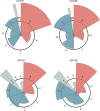Multiplex sequencing of plant chloroplast genomes using Solexa sequencing-by-synthesis technology
- PMID: 18753151
- PMCID: PMC2577356
- DOI: 10.1093/nar/gkn502
Multiplex sequencing of plant chloroplast genomes using Solexa sequencing-by-synthesis technology
Abstract
Organellar DNA sequences are widely used in evolutionary and population genetic studies, however, the conservative nature of chloroplast gene and genome evolution often limits phylogenetic resolution and statistical power. To gain maximal access to the historical record contained within chloroplast genomes, we have adapted multiplex sequencing-by-synthesis (MSBS) to simultaneously sequence multiple genomes using the Illumina Genome Analyzer. We PCR-amplified approximately 120 kb plastomes from eight species (seven Pinus, one Picea) in 35 reactions. Pooled products were ligated to modified adapters that included 3 bp indexing tags and samples were multiplexed at four genomes per lane. Tagged microreads were assembled by de novo and reference-guided assembly methods, using previously published Pinus plastomes as surrogate references. Assemblies for these eight genomes are estimated at 88-94% complete, with an average sequence depth of 55x to 186x. Mononucleotide repeats interrupt contig assembly with increasing repeat length, and we estimate that the limit for their assembly is 16 bp. Comparisons to 37 kb of Sanger sequence show a validated error rate of 0.056%, and conspicuous errors are evident from the assembly process. This efficient sequencing approach yields high-quality draft genomes and should have immediate applicability to genomes with comparable complexity.
Figures




References
-
- Birky CW. Transmission genetics of mitochondria and chloroplasts. Annu. Rev. Genet. 1978;12:471–512. - PubMed
-
- Moore WS. Inferring phylogenies from mtDNA variation: mitochondrial-gene trees versus nuclear-gene trees. Evolution. 1995;49:718–726. - PubMed
-
- Brunsfeld SJ, Sullivan J, Soltis DE, Soltis PS. Comparative phylogeography of northwestern North America: a synthesis. In: Silvertown J, Antonovics J, editors. Integrating Ecological and Evolutionary Processes in a Spatial Context. Oxford: Blackwell Science; 2001. pp. 319–339.
-
- Petit RJ, Aguinagalde I, de Beaulieu J.-L, Bittkau C, Brewer S, Cheddadi R, Ennos R, Fineschi S, Grivet D, Lascoux M, et al. Glacial refugia: hotspots but not melting pots of genetic diversity. Science. 2003;300:1563–1565. - PubMed
Publication types
MeSH terms
LinkOut - more resources
Full Text Sources
Other Literature Sources
Molecular Biology Databases

